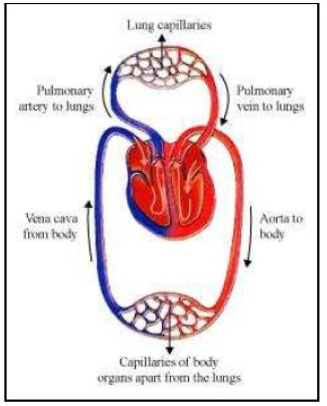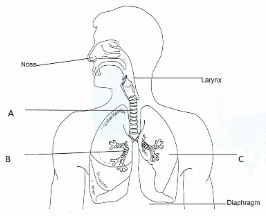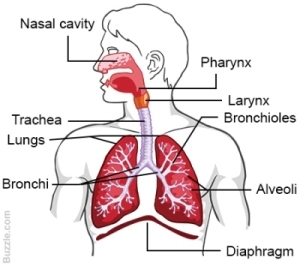CBSE Class 11 Biology – MCQ and Online Tests – Unit 17 – Breathing and Exchange of Gases
Every year CBSE schools conducts Annual Assessment exams for 6,7,8,9,11th standards. These exams are very competitive to all the students. So our website provides online tests for all the 6,7,8,9,11th standard’s subjects. These tests are also very effective and useful for those who preparing for any competitive exams like Olympiad etc. It can boost their preparation level and confidence level by attempting these chapter wise online tests.
These online tests are based on latest CBSE syllabus. While attempting these our students can identify the weak lessons and continuously practice those lessons for attaining high marks. It also helps to revise the NCERT textbooks thoroughly.
CBSE Class 11 Biology – MCQ and Online Tests – Unit 17 – Breathing and Exchange of Gases
Question 1.
Which one of the followings is correct regarding larynx?
(a) It prevents foreign objects from entering the trachea
(b) It houses the vocal cords
(c) It is an organ made of cartilage and connects the pharynx to the trachea
(d) All of these are correct
Answer
Answer: (d) All of these are correct
Question 2.
What protects the moist membranes of the respiratory tract?
(a) Mucus and cilia
(b) A c shaped cartilage rings
(c) A pebbly epidermal surface
(d) An acidic glands
Answer
Answer: (a) Mucus and cilia
Question 3.
Which of the following statements is true about Trachea in a respiratory system?
(a) It functions as passages of air to each alveolus
(b) It functions for sound production
(c) It Acts as passage of air to bronchi
(d) It Lowers the surface tension
Answer
Answer: (c) It Acts as passage of air to bronchi
Question 4.
Deoxygenated blood from heart comes to lungs via
(a) pulmonary vein
(b) systemic vein
(c) pulmonary artery
(d) systemic artery
Answer
Answer: (c) pulmonary artery
Explanation:
Question 5.
Label the parts of the human respiratory system.
(a) A- Oesophagus, B- Bronchioles, C- Lungs
(b) A- Trachea, B- Bronchioles, C- Lungs
(c) A- Trachea, B- Bronchus, C- Lungs
(d) A- Oesophagus, B- Bronchioles, C- Pleura
Answer
Answer: (c) A- Trachea, B- Bronchus, C- Lungs
Explanation:
Question 6.
Pleura is a layer covering
(a) heart
(b) kidneys
(c) lungs
(d) brain
Answer
Answer: (c) lungs
Explanation:
Double layered membrane called pleura, which covers lungs in human body.
Question 7.
Rheumatic fever can cause damage
(a) Alveoli of the Lungs
(b) heart valves
(c) heart muscles
(d) pleural membranes function
Answer
Answer: (b) heart valves
Question 8.
RBCs, plasma and biocarbonate are the medium for transport of carbondioxide. Maximum amount of carbon dioxide is carried by
(a) RBCs
(b) Plasma
(c) Bicarbonates
(d) All RBCs and bicarbonate carried 70 per cent of carbondixide.
Answer
Answer: (c) Bicarbonates
Explanation:
20-25 per cent of carbondioxide is carried by RBCs.
70 per cent is carried as bicarbonate.
7 per cent is carried in a dissolved state through plasma.
Question 9.
The maximum volume of air that can be released from the lungs by forceful expiration after deepest inspiration is called the ______.
(a) Total lung capacity
(b) Vital capacity
(c) Tidal volume
(d) Ventilation rate
Answer
Answer: (b) Vital capacity
Question 10.
The function of pneumotaxic centre is
(a) regulate inspiration
(b) regulate rhythm
(c) increase heart rate
(d) all of the above
Answer
Answer: (a) regulate inspiration
Explanation:
Pneumotaxic centre lies in pons in the brain. It regulates inspiration.
Question 11.
Which one of the following is NOT correct?
(a) The nasal cavity warms and humidifies the air before it enters the lungs
(b) The right lung is composed of three lobes, but the left lung has only two lobes
(c) Lung volumes and vital capacity measure lung function.
(d) The visceral pleura is in direct contact with the chest wall.
Answer
Answer: (d) The visceral pleura is in direct contact with the chest wall.
Question 12.
Which one of the following is NOT correct?
(a) The nasal cavity warms and humidifies the air before it enters the lungs
(b) The right lung is composed of three lobes, but the left lung has only two lobes.
(c) Lung volumes and vital capacity measure lung function.
(d) The visceral pleura is in direct contact with the chest wall.
Answer
Answer: (d) The visceral pleura is in direct contact with the chest wall.
Question 13.
Which organ lies in thoracic cavity?
(a) Heart
(b) Lungs
(c) Pancreas
(d) Both 1and 2
Answer
Answer: (d) Both 1 and 2
Explanation:
Lungs and heart both resides in thoracic cavity.
Question 14.
Which of the following statement is true?
(a) Every 100 mL of deoxygenated blood delivers approximately 4 mL of carbondioxide to the alveoli.
(b) Every 100 mL of oxygenated blood delivers approximately 4 mL of oxygen to the tissues.
(c) Every 100 mL of oxygenated blood delivers approximately 4 mL of carbondioxide to the alveoli.
(d) Every 100 mL of deoxygenated blood delivers approximately 10 mL of carbondioxide to the alveoli.
Answer
Answer: (a) Every 100 mL of deoxygenated blood delivers approximately 4 mL of carbondioxide to the alveoli.
Explanation:
Every 100 mL of deoxygenated blood delivers approximately 4 mL of carbondioxide to the alveoli.
Every 100 mL of oxygenated blood delivers approximately 5 mL of oxygen to the tissues under normal physiological conditions.
Question 15.
Trachea divides into bronchi at
(a) 4th thoracic vertebra
(b) 5th thoracic vertebra
(c) 6th thoracic vertebra
(d) 7th thoracic vertebra
Answer
Answer: (b) 5th thoracic vertebra
Explanation:
Trachea is a straight tube extending up to the mid-thoracic cavity. It divides into bronchi at 5th thoracic vertebra.
Question 16.
Aerobic respiratory pathway is also termed as ______ pathway.
(a) Anabolic
(b) Catabolic
(c) Creatine phosphate
(d) Amphibolic
Answer
Answer: (d) Amphibolic
Question 17.
The oxygen dissociation curve is shifted to the right by an increase in ______.
(a) H+ concentration
(b) PCO2
(c) temperature
(d) All of these
Answer
Answer: (d) All of these
Question 18.
The maximum volume of air contained in the lung by a full forced inhalation is called
(a) Vital capacity
(b) Tidal volume
(c) Total lung capacity
(d) Inspiratory capacity
Answer
Answer: (c) Total lung capacity
Question 19.
______ lies in front of esophagus.
(a) Trachea
(b) Glottis
(c) Larynx
(d) Epiglottis
Answer
Answer: (a) Trachea
Question 20.
In brain, respiratory control centre lies in
(a) pons
(b) medulla oblongata
(c) hypothalamus
(d) cerebrum
Answer
Answer: (b) medulla oblongata
Explanation:
Respiratory control centre or respiratory rhythm centre lies in medulla oblongata.
Pneumotaxic centre which lies in pons region of the brain can moderate the functions of the respiratory rhythm centre.














0 Comments:
Post a Comment